1
A Short History of Bicycling
Introduction
Those who are ignorant of history are not, in truth, condemned to repeat it, as George Santayana claimed. However, people do spend a great deal of time reinventing types of bicycles and components, and one purpose of this necessarily brief history is to give would-be inventors a glimpse of some of their predecessors. Sir Isaac Newton said that we make advances by standing on the shoulders of giants, but to do that, we must first know that there were giants and what they accomplished. Another purpose is to kill the many-headed Hydra of bicycling myths. People invent these myths—for instance, that Leonardo da Vinci or one of his pupils invented the chain-driven bicycle—for nefarious or self-serving or humorous purposes, and journalists and enthusiasts pick them up, and they almost instantly become lore, however false. Historians repeatedly denounce the fakes, but the amateur historians continue to report them as if they were true. These people seem to practice a crude form of democracy: if they read something in ten publications and the contrary in one, then the one reported most often is, they believe, correct.
We have become the disciples of a group of cycle historians that has become a powerful international movement having scholarly proceedings and meetings. The late Derek Roberts, the group’s founder, wrote correction sheets for every new book incorporating cycling history, pointing out inaccuracies in detail. At the encouragement of the late John Pinkerton, a prominent member of the group and a publisher of cycling-history books, Roberts gathered these inaccuracies and corrections together and published Cycling History—Myths and Queries (1991) in a further attempt to stem the tide of inaccurate versions of history. This present brief history endeavors to lay to rest previous myths and does its utmost not to create more. We have been graciously guided by Roberts, by Pinkerton, and by Hans-Erhard Lessing, a leading cycle historian, former curator, and university professor, who himself has documented several major bicycling myths (some quoted later in this chapter) previously regarded as historical facts. Others in this group who have been of particular help to us are Nick Clayton and David Herlihy. Cycle historians themselves are far from agreement on many aspects of their profession: cycle history is a field in which views are strongly held and defended and amateurs must tread with great care; we have greatly appreciated this group’s advice, which has not always been unanimous.
There have been three significant periods in cycling history, each covered in more detail in this chapter. Despite the myths of supposed earlier two-wheelers, the first bicycle (a “running machine” that the rider straddled and propelled with his feet on the ground) was invented in Germany in 1817, and this is when the history of the bicycle and motorcycle begins. That first bicycle found a promising acceptance in several countries but was suppressed by the authorities in Mannheim (late 1817), Milan (1818), London, Philadelphia, New York (1819), and Calcutta (1820), so that by 1821 it had virtually died out (Lessing 2017). However, Lessing (2017) records “running-machine races in April 1829” in Munich “of 26 machines taking part.” Others, including Pinkerton, believed that the enthusiasm for running machines was simply a fad of the rich and that it would come and go as such fashions do. Not until the early 1860s did someone in France add cranks and pedals to the front wheel of a running machine, at which point international enthusiasm redeveloped. If a modern bicycle is defined as a vehicle having two wheels in line connected by a frame on which a rider can sit, pedal, and steer so as to maintain balance, then this French running machine is the start of its history. The enthusiasm over this machine lasted much longer than that of 1817–1821. The front wheel was made progressively larger, and the high bicycle or “ordinary” was born. It was fun but it was dangerous, although Pinkerton, a long-time rider of high bicycles, believed the supposed dangers to be highly exaggerated. Designers and inventors tried for many years to arrive at a safer machine. Success came with the so-called safety, first in 1878 with the Xtraordinary and the Facile, and reaching significant commercial success with John Kemp Starley’s 1885 safeties, which, with Dunlop’s pneumatic tires reinvented in 1888, became by 1890 very similar to the safety bicycle of today.
These, then, are the three principal developments that this short history discusses. It also mentions the tricycle period, the repeated enthusiasm for recumbent bicycles, and some modern developments.
Early History
It was through the use of tools that human beings raised themselves above the animals. In the broadest sense of the term, a tool might be something as simple as a stone used as a hammer or as complex as a computer controlling a spacecraft. The discussion here is concerned with the historical and mechanical range of tools that led to the bicycle, which—almost alone among major human-powered machines—came to use human muscles in a near-optimum way. A short review of the misuse of human muscle power throughout history (Wilson 1977) shows the bicycle to be a brilliant culmination of the efforts of many people to end such drudgery.
Many boats, even large ones, were muscle powered until the seventeenth century. Roman galleys had hundreds of “sweeps” in up to three banks. Figure 1.1 shows a large seventeenth-century galley having fifty-four sweeps, with five men on each. The men were likely to be criminals (real or supposed), chained to their benches. Overseers equipped with whips patrolled a central gangway to provide persuasion for anyone considered to be taking life too easy. These unfortunate oarsmen used muscle actions typical of those considered appropriate in the ancient world. The hand, arm, and back muscles were used the most, while the largest muscles in the body—those in the legs—were used merely to provide props or reaction forces. (These early oarsmen didn’t have the sliding seat available to today’s competitive rowers.) The motion was generally one of straining mightily against a slowly yielding resistance. With five men on the inboard end of a sweep, the one at the extreme end would have a more rapid motion than the one nearest to the pivot, but even the end man would probably be working at well below his optimum speed. Muscle use in most farm work and forestry fell into the same general category. Hoeing, digging, sawing, chopping, pitchforking, and shoveling all employed predominantly the arm and back muscles, with little useful output from the leg muscles. In many cases, the muscles had to strain against stiff resistances; it is now known that muscles develop maximum power when they are contracting quickly against a smaller resistance, in what is termed a good impedance match. In the bicycling context specifically, this good impedance match might be called an optimum gear ratio.

Figure 1.1
Early-seventeenth-century galley, with drummer in the stern and whip-bearing overseer on the central gangway. (From a drawing in the British Museum reproduced in the Encyclopedia Britannica, sketched by Dave Wilson.)
One medieval example of the use of appropriate muscles in a good impedance match is the capstan, around which several people walked in a circle, pushing on radial arms, to winch in a rope. The capstan’s diameter was chosen to provide comfortable working conditions, and each pusher could choose a preferred radial position on the bar. The same principle has been reversed with the horizontal treadwheel. Inclining the treadwheel makes a more upright position possible, and the arms can push less. Finally we arrive at the vertical treadwheel, with a horizontal axis. Numerous configurations are possible, the most popular apparently the hamster drum type used in countless medieval cranes and mills, hence also the name treadmill, still used today for modern horizontal or inclined endless belts for exercise and ergometry.
Rarer is the outside-stair-cage type of treadmill suggested by Leonardo da Vinci for powering armaments. Later examples are also sinister, serving to enforce hard labor in penal institutes. They were “invented” by an English engineer, and ten large penal treadmills were constructed for the Brixton prison from 1821 onward, connected to two millstones and water pumps. Ten to twenty prisoners at a time could work each wheel for grinding flour. Unlike the galley sweeps, the capstans, or even the hamster drum type of treadwheels, all of which at least allowed workers some choice of force applied, the nefarious Brixton wheel design required each prisoner to exert exactly his own weight at the same rate as all the others. This rate was maintained by a centrifugal mechanism operating a bell (The Mirror 1822). The data given in Walton 2015 and Katch, McArdle, and Katch 1997 differ but do suggest that prisoners had to work at rates between about 120 W and 250 W for many hours per day, and being poorly nourished, often became ill. By midcentury, about one hundred English prisons, and a few in British colonies as well as in the United States, were so equipped, resulting in several maimed and killed prisoners (Vaver 2013). This form of punishment wasn’t discontinued until 1902. A working model survives, or was reconstructed, in South Africa (figure 1.2).
Augustino Ramelli proposed a number of novel or even unique treadmills, including what might be the only semirecumbent treadmill for a seated person (figure 1.3). The type of work involved may not have been pleasant, but it was far more congenial than that required of a galley slave or Victorian prisoner, and the view was better. Note the gearing: first stepped up, then heavily stepped down.
The first clearly human-powered vehicles known to history (if classes like wheelbarrows and carts pulled or pushed by men and women are excluded) were carriages supposedly propelled by footmen, in France in the 1690s (Ritchie 1975, 16). (An alleged earlier effort by a pupil of Leonardo da Vinci has been convincingly shown by Lessing to be a fake.)

Figure 1.2
Triple treadmill used to punish prisoners at Breakwater Prison (now Breakwater Lodge), Cape Town, South Africa. (Photo by Lennon001, licensed CC-BY-SA 3.0.)

Figure 1.3
Semirecumbent treadmill powering geared winch. (From Gnudi and Ferguson 1987.)
The First Bicycle
It seems likely that the most important discovery in the development of the bicycle was made by chance. Baron Karl von Drais, a resident of Mannheim, studied mathematics and mechanics in Heidelberg and invented a binary digit system, a paper-strip piano-music recorder, a typewriter, and—during a series of bad harvests after 1812—two human-powered “driving machines” on four wheels. In 1815 the Indonesian volcano Tambora exploded, expelling the greatest known mass of dust into the atmosphere (estimated at seven times the amount from Krakatoa in 1883) and making 1816 “the year without a summer” in central Europe and the New England states. Starvation was widespread, and horses were killed for lack of fodder, the price of oats then playing the same role as the oil price fairly recently. Lessing (1995) believes that the consequent shortage of horses led von Drais to develop his two-wheeled “running machine” with front-wheel steering from the outset (figure 1.4). An earlier assumption was that he had no preconception that the steering would enable him to balance but simply thought that it would be a convenience. However, Lessing (1995, 130) makes a powerful argument that ice skating, which “had long been a means of travel and transport in the Netherlands with its many canals,” led to roller skating. Lessing quotes sources describing “a pair of skates contrived to run on small metallic wheels” to imitate ice skating on theater stages between 1761 and 1772. A preserved flyer for an outdoor demonstration between The Hague and Scheveningen in 1790 shows what appear to be the earliest in-line roller skates. These did not appear in technological magazines of the time, and it is therefore hard to tell if von Drais had knowledge of them. But von Drais was an ice skater himself, so balancing on one foot on a skate could have started him thinking about something larger, necessarily with steering. (As discussed later in the chapter, in 1863, James Plimpton patented roller skates that could be steered, which made him a multimillionaire [Lessing 1995].) A better-documented influence was the rediscovery of the Chinese wheelbarrow (using even a sail) with its central wheel under the load, since this was a topic at the University of Heidelberg.

Figure 1.4
Draisienne or Draisine. Von Drais chose a wheel diameter of 690 mm (27 in). From von Drais’s plans by Joachim Lessing; the cloak and side panniers are reconstructed. (Courtesy of Hans-Erhard Lessing.)
However it was attained, the major discovery in bicycle history had been made, and it was scarcely recorded. Von Drais’s vehicle was, however, noted in the German newspapers in 1817 and those of the United Kingdom in 1818 and the United States in 1819. In Paris, where von Drais obtained a five-year patent, it was called le vélocipède (and in fact, from 1817 to 1870, the term velocipede was used in English for any foot-propelled vehicle) or la draisienne, and Draisine in German and English. In Britain it became known as the Pedestrian Accelerator and was nicknamed Hobby Horse (Street 1998). (Live horses needed constant care. These mechanical “horses” could be used or left at will and were thus treated as a hobby.)
Despite some initial skepticism and ridicule, von Drais was soon demonstrating that he could exceed the speed of runners and that of horse-pulled posts, even over journeys of two to three hours. His ability to balance when going down inclines and to steer at speed must have been important in this, and it awed the unathletic majority of the population. He indeed must have the principal claim to being the originator of balance on two wheels by steering.
Von Drais had many imitators. One was the London coachmaker Denis Johnson, who made a seemingly more elegant conveyance having a mainly iron rather than wooden frame (it was therefore heavier). It was soon called the Dandy Horse. Johnson set up a school in which young gentlemen could learn to ride. In the next year or so, use of the vehicle could be considered to have spread to clergymen, mailmen, and tradesmen, if contemporary cartoonists are to be taken seriously. However, its cost was too high for it to be used by any but the rich. In 1821, Lewis Gompertz fitted a swinging-arc ratchet drive to the front wheel (figure 1.5) so that the rider could pull on the steering handles to assist his feet. However, by this time so many restrictions had been put upon velocipedes that they lost their usefulness: “for they gave orders that those who rode velocipedes should be stopped in the streets and highways and their money taken from them. This they called putting down the velocipede by fines” (Davies 1837). John Pinkerton, in a 2001 communication to the senior author, indicated he believed that Davies was exaggerating: velocipede users were almost exclusively the very rich and therefore unlikely to be harassed.
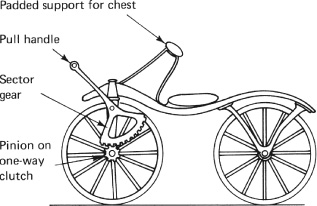
Figure 1.5
Gompertz’s hand drive. (Sketched by Dave Wilson.)
Von Drais’s premier place in what might be regarded as the three-step history of the development of the safety bicycle is assured, and it is relatively free from controversy. In contrast, the second and third steps (and “steps” seems an appropriate name, for they each resulted in “step-changes” in bicycle performance) are shrouded in some mystery and arguments among present-day proponents of one claimant or another.
In previous editions of this book, and in many other reputable books on bicycle history, including Ritchie 1975, credence has been given to a second step being taken in Dumfriesshire, Scotland, in 1839 or 1840 by Kirkpatrick Macmillan, who had been thought to have fitted cranks to the (large) rear wheel of a bicycle, with connecting rods going to swinging arms near the front-wheel pivot point. Alas, bicycle inventors seldom leave behind much incontrovertible evidence, and this is certainly true of Macmillan. His claimed development is reckoned by Nicholas Oddy (1990), Hans-Erhard Lessing (1991), and Alastair Dodds (1992) to be another myth. Lessing points out that in the chauvinistic atmosphere of that period (and later), unscrupulous people repeatedly manufactured “proofs” that someone from their own countries was the first to invent some notable device. (The velocipede credited to Macmillan by a relative, shown in figure 1.6, was actually the McCall velocipede of 1869, which belongs to the second step in our three-step history.) However, others believe with conviction that Macmillan did in fact produce a rideable pedaled bicycle much earlier than this.

Figure 1.6
Copy of the velocipede attributed by some to Kirkpatrick Macmillan, built around 1869 by Thomas McCall of Kilmarnock. (Reproduced, with permission, from Ritchie 1975.)
As implied earlier in the chapter, the Hobby Horse–velocipede “boom” had died down substantially by 1821. The second step in bicycle development had to wait until the 1860s (see the next section). Why so long? One can speculate that the countries in which two-wheeled vehicles had been developed and received with such enthusiasm—principally Germany, France, Netherlands, the United States, and Britain—were subsequently in the grip of railway mania. There was a new, fast way to travel, and this technology lured the creative dreams and efforts of inventors and mechanics away from the more mundane human-powered transportation. The parallels between this and what was to happen eighty years later, when the enthusiasm for the safety bicycle was to evaporate before the flaming passion for the automobile, are striking. Lessing (1995) points out that roller skating had lost its popularity on the arrival of the safety bicycle, with the rinks closing down in Europe, but not in the United States.

Figure 1.7
Sawyer four-wheeled velocipede. (Reproduced, with permission, from Ritchie 1975.)
It would be an exaggeration to claim that all development in human-powered vehicles stopped during this time, however. Such vehicles were used during the period by some enthusiasts (including Prince Albert, husband of Queen Victoria), but not extensively. The machines’ size, weight, and cost and the poor roads of the time deterred walkers from changing their mode of travel. Willard Sawyer, a coachmaker in Kent, England, made increasingly sophisticated four-wheeled velocipedes, such as that shown in figure 1.7, and exported them around the world, from about 1840 to 1870 (McGurn 1999, 24–26). They too were used by a few enthusiasts, but no movement developed. Undoubtedly there were lone mechanics and inventors in various countries making what seemed to be improvements to the Draisine.
The Second Step: Pedaling Propulsion
The next step in bicycle development has become highly controversial. The second edition of this book added a chapter on bicycle history and credited Pierre Michaux with the significant step of adding pedals and cranks to the front wheel of a Draisine, thus initiating the astonishing period that lasted from the 1860s to the turn of the century when at least some parts of the earth appeared to have gone “bicycle crazy.” Michaux certainly produced pedaled velocipedes in increasing numbers in 1867–1869 (such as, for example, the one depicted in figure 1.8), but there appear to be a half-dozen other “first” originators, with no clear winning candidate for the title (see Hadland and Lessing 2014).
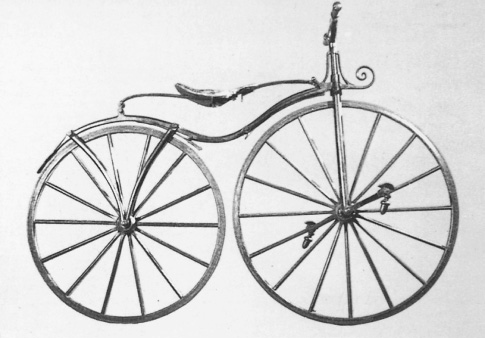
Figure 1.8
First commercial Michaux velocipede. (From Clayton 1998.)
Whoever deserves the credit, there is no doubt about the results. A wild enthusiasm for le vélocipède bicycle started in Paris in 1868 and spread to Belgium, the Netherlands, Germany, the United States, and Britain. The first true bicycle boom was underway.
Why, and why then? Hans-Erhard Lessing claims that having learned to ride a bicycle during childhood, most of us are unable to understand the fear of balancing of former times (unless we try to teach cycling to an unknowing adult). This fear hindered earlier mechanics in thinking of two-wheelers with the rider’s feet permanently off safe ground. Sometime after Meyerbeer’s opera Le prophète, with roller skaters on stage, promoted roller skating throughout the Continent in the 1840s, ice skaters developed the new art of figure skating. Trying to imitate this on roller skates created the need for “rocking” roller skates with rubber-block steering invented by a Bostonian, James Plimpton, in 1863. Plimpton’s empire of covered roller-skating rinks where the roller skates were rented, never sold, spanned the United States, Europe, and the whole Commonwealth. Roller skating became all the rage in the 1860s, and a large percentage of the rich learned to balance with both feet on wheels. Only on the basis of this broad balancing experience could someone on a two-wheeler ask: Why not take the feet off the ground permanently and put them on cranks? Moreover, Paris during this time got new macadamized boulevards that eased the use of the new machines, which had double the weight of the Draisines. But above all the machines were fun to ride, and thousands did so unimpeded by the authorities.
We might not find their experience so entrancing nowadays. The wooden wheels of the machines they rode had thick compression spokes and iron rims. It was only in the late 1860s that rubber was fastened onto the rims to cushion the harsh ride and ball bearings were first used to give easier running, although Davies (1837) mentions that some Draisines were fitted with “friction rollers” to lessen the friction. When French bicycle factories were subsequently required to turn to armaments in the Franco-Prussian war of 1870–1871, French leadership in bicycle development was lost (Ritchie 1975).
What of the apparent lack of American contributions to the mainstream of bicycle development? What happened to the Yankee genius in engineering and mechanics? The US Patent Office was in fact flooded with applications to patent improvements to velocipedes from 1868 on. French and British makers then found it necessary to follow the developments taking place across the Atlantic. In 1869 Pickering’s Improved Velocipedes were exported from New York to Liverpool. But the American craze, which Scientific American stated had made the art of walking obsolete, suddenly petered out in 1871, as quickly as it had started, leaving new businesses bankrupt and inventors with nowhere to go (Ritchie 1975). There was then a lull until 1877, when the high-wheel bicycle was imported from Europe. Colonel Albert Pope started manufacturing them in the United States a year later. But conditions there were less conducive for bicycles than those in Europe, where the high bicycle enabled people to travel much farther than was comfortably possible on a velocipede. In Britain the roads were good enough for the country to be traversed from Lands End in southwest Cornwall to John O’Groats in northeast Scotland (924 mi; 1,490 km) in seven days (Ritchie 1975); in the United States the distances between towns were (except perhaps in New England) enormous, and the roads were poor. Accordingly, the bicycle did not have, and did not convey, as much freedom as in Europe, and the market was therefore smaller and far more dispersed than in Europe. It is doubtful that anyone in the United States used bicycles for long-distance travel except a few enthusiasts and people who wanted to set records.
Development was rapid in Britain, however, where production had been undertaken more to fill the unsatiated French demand than to supply any domestic market. James Starley (uncle of John Kemp Starley) used his sewing-machine factory to build up a thriving bicycle industry in Coventry and repeatedly assumed technical leadership in the area. The suspension or tension wheel was developed in Paris by Eugene Meyer in 1869 (Clayton 1997) and William Grout in 1870. At about the same time, Starley and William Hillman introduced the lever-tension wheel, with radial spokes and a lever for tensioning and torque transmission (figure 1.9), and in 1874 Starley patented the logical extension of this idea, the tangent-tension method of spoking, the standard spoking method to this day (shown in figures 1.13 and 1.17).

Figure 1.9
Starley-Hillman lever-tension wheel (circa 1870), shown by the late John Pinkerton in 2001. (Photo by Dave Wilson.)
The High-Wheeler or Ordinary
With the advent of tension spoking, front wheels could be and were being made larger and larger to give a longer distance per pedal revolution and therefore greater speed. Starley patented his Ariel bicycle, which already had a larger-than-normal driving wheel, on August 11, 1870. (For a while, some French race organizers tried to restrict the diameter to about a meter [Dodge 1996, 58]—perhaps a harbinger of the restrictions later imposed by the Union Cycliste Internationale?) Starley and others recognized the advantages of using a geared step-up transmission, but experimenters found that the available chains quickly froze up in the grit and gravel of contemporary roads. Soon front wheels were made as large as comfortable pedaling would allow, and one bought one’s bicycle to fit one’s inside leg length. The largest production “high-wheeler” or “ordinary” (also referred to as a “penny-farthing”) would have a driving wheel about 60 inches (about 1.5 m) in diameter (figure 1.10). (In the English-speaking world, we still translate gear ratios into equivalent driving-wheel diameters, and this size corresponds to the middle gear of a typical modern bicycle. The French and others in Europe instead use la developpement, the wheel’s circumference, the distance traveled in one full turn of the cranks.)

Figure 1.10
Ordinary, high-wheeler, or penny-farthing. (From Sharp 1896.)
The 1870s were the years of the high-wheeler’s dominance. By the end of the decade, top-level bicycles were made with ball bearings in both wheels and in the steering head, the rims and forks were formed from hollow tubing, the steer axis had been tilted to create a castering effect, the tire rubber was greatly improved over the crude type used in 1870, and racing bicycles had been reduced to under 30 lb (13.6 kg). A rideable ordinary weighing only 11 lb (5 kg) was produced in 1889.
The ordinary was responsible for the third two-wheeler passion, concentrated among the young upper-class men of France, Britain, and the United States and fostered by military-style clubs with uniforms and even buglers (Dodge 1996, 82–88). The ordinary conferred unimagined freedom on its devotees; it also engendered antipathy on the part of the majority who didn’t or couldn’t bicycle. Part of that antipathy was envy. The new freedom and style were restricted to rich young men. Strict dress codes prevented all but the most iconoclastic of women from riding high-wheelers. Family men, even if they were still athletic, hesitated to ride because of the reported frequent severe injuries to riders who fell (some feel that these reports were exaggerated). Unathletic or short men were excluded automatically. Many prospective riders among these groups took instead to tricycles (Sharp 1896, 165–182), which for a time were produced in as many models as the ordinaries.
The need to serve this “extra-ordinary” market produced two technological responses. James Starley played a prominent role in the first, and his nephew, John Kemp Starley, in the second.
Tricycles and Quadracycles
The first of these responses was the development of practical machines of three or four wheels that eliminated the need to balance and allowed the rider to be seated in a comfortable, reasonably safe, and perhaps more dignified position. Such vehicles had been made at different times since at least the start of the century, but the old heavy construction made propelling them a formidable task. In fact, one or more servants, who in effect substituted for horses, allegedly often provided the motive power (there is considerable doubt about the truth of these reports). Women in conventional dress and relatively staid males could use Starley’s Coventry Tricycle, patented by Starley’s son and nephew in 1876 and produced by the Starleys for several years from 1877 on, with comparative ease. Early in the production run it was driven by a lever system and called the Coventry Lever. However, Starley had found a chain that worked, at least in the possibly more protected conditions of a tricycle, and produced later versions with rotary pedals; these were referred to as the Coventry Rotary (figure 1.11). The Coventry Tricycle and its successors had one large driving wheel on the left of the seat and two steering wheels, one in front and one behind, on the right. Starley saw the advantage, however, of a different arrangement, with two large driving wheels on either side of the rider(s) and a single steering wheel in front. For this arrangement to work, however, power had to be transmitted to two wheels, which, during a turn, would be going at different speeds. To solve the problem, Starley reinvented the “balance gear” (Sharp 1896, 240–241), now known as the differential. Starley’s Royal Salvo tricycle, which incorporated the improved design, became the predominant form—for single riders, for two sitting side by side, and even for one rider sitting behind the other (figure 1.12). This is not to say that there were no other forms; tradesmen’s carrier machines, for instance, with the steering wheel trailing the large driving wheels, used the reverse of this arrangement (Pinkerton 1983). But the front steerer was perceived as giving better control (one did not have to steer the rear wheel toward a pedestrian or a pothole to take avoiding action, as is necessary with rear steerers).
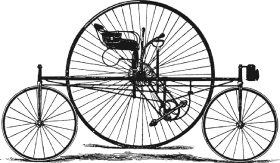
Figure 1.11
Starley’s Coventry Rotary tricycle. (From Sharp 1896.)
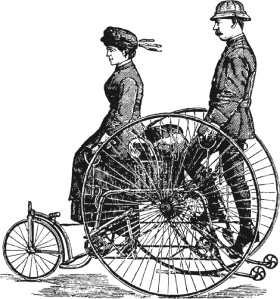
Figure 1.12
Starley’s Royal Salvo tricycle. (From Sharp 1896.)
Gradually the tricycle’s front wheel was made larger and the driving wheels smaller, as chain drives of increasing efficiency and reliability made possible. By 1884 or 1885, the front wheel was connected directly to the handlebars (figure 1.13), a simpler and more reliable arrangement than the rack-and-pinion and other indirect systems that had been used. The modern tricycle had evolved, with the modern riding position in which one sits or stands almost over the cranks and splits the body weight among handlebars, pedals, and saddle. (Today’s modern tricycles and quadracycles are mostly recumbents with seats rather than saddles and are described in later chapters.)
Final Improvements to the Ordinary
This modern tricycle of late 1884 or early 1885 was also very similar to the emerging form of the modern bicycle. In fact, the second response to the exclusion of so many from the high-wheeler movement was the development of a configuration that would make a headfirst fall from a considerable height less likely, could be ridden in conventional dress, and did not require gymnastic abilities.
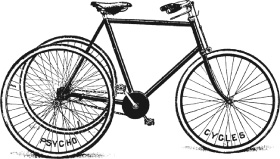
Figure 1.13
Early modern tricycle. (From Sharp 1896.)
Some improvements to the high-wheeler fulfilled only the first of these desiderata. Whatton bars (figure 1.14) were handlebars that came under the legs from behind, so that in the event of a pitch forward the rider could land feet first. (Cycle clubs—but not the police—recommended that riders of standard high-wheelers put their legs over the handlebars when going fast downhill, as in figure 1.15, for the same reason.) Some modern recumbent bicycles have similar handlebar arrangements. The American Star’s designer took the approach of making over-the-handlebars spills much less likely by putting the bicycle’s small wheel in front, giving it the steering function, and reducing the wheel size by using a lever-and-strap drive to the large wheel through one-way clutches (figure 1.16). Unfortunately, this innovation arrived too late to have much impact, in 1881, because by that time the true “safety” bicycle was evolving rapidly. Another type of bicycle that was safer to ride than the high ordinary was the “dwarf” front driver, such as Hillman’s 1884 Kangaroo (figure 1.17 shows an 1886 Kangaroo Dwarf Roadster), with a geared-up drive to a smaller front wheel (Sharp 1896, 152, 158). Machines like the Kangaroo were offered because riders accustomed to front-drive machines did not always take kindly to the rear-drive safeties. Small-wheeled Bantam bicycles with an epicyclic hub gear (figure 1.18) were marketed as late as 1900.
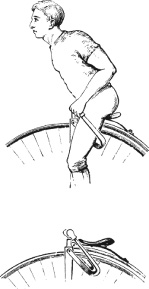
Figure 1.14
Whatton bars. (From Cycling 1887.)
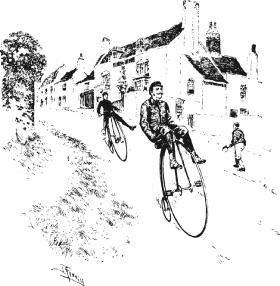
Figure 1.15
“Coasting—Safe and Reckless.” (From Cycling 1887.)
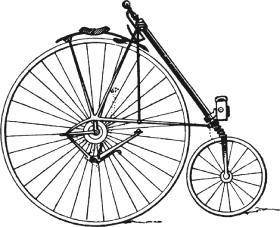
Figure 1.16
American Star, a treadle-action bicycle (1880). (From Baudry de Saunier 1892.)
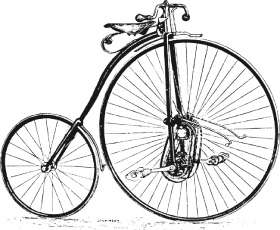
Figure 1.17
1886 Kangaroo Dwarf Roadster. (From Sharp 1896.)
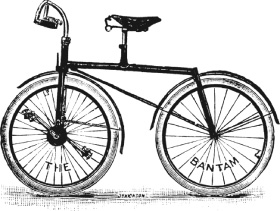
Figure 1.18
Bantam geared front-drive safety bicycle. (From Sharp 1896.)
The Third Step: The Arrival of the Modern Safety Bicycle
It had long been recognized that it would be most desirable from the viewpoint of safety to have a bicycle’s rider sitting between two wheels of moderate size. Many attempts at achieving this arrangement were made over the years. Rubber tires, variable gears, freewheels, tubular frames, sprung wheels, and band brakes were shown at the first Paris velocipede show in 1869. But the direct ancestors of today’s bicycles evolved rapidly in the one or two years before 1885, when several were shown in Britain’s annual Stanley Bicycle Show. James Starley had died in 1881, but his nephew John Kemp Starley, working with William Sutton, produced a series of Rover safety bicycles (Pinkerton and Roberts 1998) in 1885 that, by the end of that year, had direct steering and something very close to the diamond frame used in most bicycles today (figure 1.19).
One major development in the mainstream flowing to the modern bicycle remained: the pneumatic tire, patented in 1888 by John Boyd Dunlop, a Scottish veterinarian in Belfast, although another Scot, R. W. Thomson, had patented pneumatic tires for horse-drawn vehicles in 1845 (UK Patent 10,990). Dunlop’s early tires (made to smooth the ride of his son’s tricycle) were crude, but by May 1889 W. Hume was using them in bicycle races in Belfast—and he won four out of four. Success in racing in those days gave a clear signal to a public confused by many diverse developments. Cyclists saw, as in the case of the safety versus the high-wheeled bicycle, a development that promised not only greater speed, or the same speed with less effort, but greater comfort and (especially) greater safety. Within eight years, solid tires had virtually disappeared from new bicycles, and Dunlop was a millionaire in pounds sterling.
With the arrival of the pneumatic-tired direct-steering safety bicycle, only refinements in components remained to be accomplished before the modern-day bicycle could be said to have fully developed. Various types of epicyclic spur-gear variable-ratio transmissions for the brackets and rear hubs of chain-driven safety bicycles came on the market in Britain in the 1890s. Some heavier devices were available earlier for tricycles. The Sturmey-Archer three-speed hub (1902) was the predominant type, as it still is in many parts of the world (Hadland 1987), but it had many competitors. The derailleur or shifting-chain gear was developed in France and Britain in 1895 but was not popular. After further development by degrees in Europe, it was eventually accepted for racing in the 1920s (Berto, Shepherd, and Henry 1999).
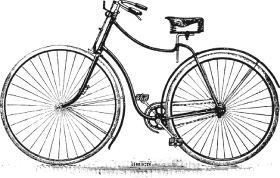
Figure 1.19
Starley safety bicycle. (From Sharp 1896.)
Undoubtedly, much more will be discovered about the history of the modern traditional single-rider bicycle, and heretofore unrecognized inventors will receive the honor due them. Inquiring readers can find much more history than this book has space for in the excellent books referenced.
Waxing and Waning Enthusiasm
Although the enormous enthusiasm for the bicycle in most “Western, developed” countries in the 1890s waned sharply toward the end of the decade, that is not to state that the bicycle fell into wide disuse. Not many workers could afford bicycles, but well-to-do people used them for commuting and shopping, and later, in Europe at least, the “cloth-cap” (i.e., working) class used them also for sport and for weekend and vacation travel. The hapless senior author was not allowed to ride a bicycle until he was nine (and then he was allocated an old single-speed clunker), and he was given an old three-speed “sports” bike when he was eleven, in 1939, the year war was declared in Europe. Petrol (gasoline) was first rationed and then made unavailable for private use in Britain during World War II, and the bicycle was therefore used widely at the time. Riding with his elder brothers and mother and father was an important part of growing up. Going with his schoolboy friends to see local bomb damage and downed planes, to visit local towns for attractions such as swimming holes, and to plan increasingly longer trips ending with a 1,000 mi (1,600 km) tour into Scotland in 1944 were all liberating and character-forming activities. The camaraderie of European bicyclists everywhere made trips of any length very enjoyable.
The return to availability and affordability of motor fuel and cars after the Second World War ended reduced the bicycle in many Western countries to being used by children and what were seen as fringe groups. In the developing world, however, the bicycle was a necessity for anyone who could afford one. In most of these countries and especially in China, the proportion of person-trips and even of freight moved by bicycle was far higher than that carried by the railroads and road traffic.
A modern bicycle boom started in the United States about 1970, for reasons difficult to discern. (It followed rather closely the end of a two-year competition in the design of human-powered vehicles organized by the senior author that created considerable public interest at the time, which tempted him to puff himself up to take credit, just as the cock crows at the dawn he has obviously caused.) Annual sales of bicycles rose rapidly to exceed comfortably those of automobiles. The buyers were overwhelmingly middle-class, college-educated, and professional people, US bicyclers thereby contrasting with users in Britain. The bicycles were relatively lightweight models for road use; at the start, the popular style was the “English bicycle,” predominantly Raleigh three-speed models, but soon “English racers” (an increasing proportion actually being French and Japanese), later called “ten-speeds,” became fashionable, although we suspect that many of those purchased were not actually used much.
Although the bicycle represents a huge success story, its usage is again at a decline just when it is needed most, both for health and ecological reasons. Because worldwide usage is difficult to assess, Oke et al. (2015) examine the minimal bicycle ownership of private households in 150 countries. Overall the percentage of households that own at least one bicycle has in the last few decades decreased from about 60 to 40. In most parts of Africa and central Asia the proportion is about half of this, and in northern Europe as well as Burkina Faso, it is twice this figure. Standard bicycle usage may be in decline, but newer special forms of the bicycle, some of which we mention later in this chapter or in other chapters, are becoming more popular.
All-Terrain Bicycles
In 1970, at the time the enthusiasm for lightweight road bikes in the United States was increasing, a few enthusiasts in Marin County, California (by coincidence also the decade-long home of the coauthor), began experimenting with old Schwinn clunkers for downhill off-road racing (Berto 1998). Others had done so in different countries before this, but they had not started a movement. Nearly thirty years later, Frank Berto interviewed nine then-young men who, in this small area of California, continued experimenting throughout the 1970s with configurations of bicycles that gave advantages first for fast purely downhill travel and later for cross-country and uphill riding. Several started companies to produce the designs they developed. Rather suddenly, “beginning around 1982, a sea change affected the sales of bicycles in America and Europe. The buyers switched from road bikes to all-terrain or ‘mountain’ bikes. Tires went from skinny to fat, and riders went from a crouched position on dropped handlebars to a more erect position on flat handlebars” (Berto 1998, 25). This second boom in bicycle popularity differed in character from the road-bike boom, because a far higher proportion of the bikes purchased were used to a significant extent. Perhaps most were not in fact used for off-road recreation but as extremely practical bikes for negotiating rough urban streets in commuting or shopping use. They left far behind their original heavy clunker image and became high-tech lightweights. They reached extraordinary levels of sophistication, many having front and rear suspension, wide-range twenty-seven-speed gears, hydraulic disk brakes, and frames made from aluminum, titanium, or carbon fiber. The technology developed for these so-called mountain bikes led the bicycle industry for some decades. Many bicycles today called “city bikes” have benefited from this technology.
Recumbents
One reason for discussing recumbents while excluding tandems, folding bicycles, pedicabs, or goods transporters (often themselves recumbents) from this discussion is that most modern record-breaking bicycles are recumbents. Another is that greater safety can result from the use of the recumbent riding position.
Many early cycles (particularly tricycles) placed their riders in a semirecumbent position. The early “boneshakers” with solid tires were often ridden with the saddle well back on the backbone spring and the feet at an angle considerably higher than that for the modern upright safety. In contrast with riders of the high-wheeler and of the safety, who were told to position the center of gravity vertically over the center of the crank, semirecumbent riders sat in something like a chair and put their feet out forward on the pedals. The pedal-force reaction was taken not by the weight of the body (or when that was exceeded, by pulling down on the handlebars), but by the backrest.
The first known semirecumbent bicycle (that is, one in which riders’ center of gravity is low enough relative to the front-wheel road contact point to make the possibility of their being thrown over the front wheel in an accident negligibly low) was built in Geneva by Charles Challand (von Salvisberg 1897, 47) sometime before 1895 (figure 1.20). On Challand’s Normal Bicyclette, the rider sat rather high, directly over the rear wheel. In 1897 US Patent 577,895 was awarded to I. F. Wales for a somewhat strange-looking recumbent bicycle with hand and foot drive (figure 1.21) (Barrett 1972). An American named Brown constructed a much more modern-looking recumbent bicycle (figure 1.22), the Sofa Bicycle, and took it to Britain in 1901 (Dolnar 1902). By this time orthodoxy rested firmly with the traditional safety bicycle, and the derision that had successively greeted the Draisine, the velocipede, and the safety had been forgotten. Dolnar’s review of the Brown recumbent in The Cyclist of January 8, 1902, was derisive to the point of sarcasm: “The curiously unsuitable monstrosity in the way of a novel bicycle shown in the single existing example of Mr. Brown’s idea of the cycle of the future here illustrated ... fully show(s) the rider’s position and the general construction of this crazy effort. ... The surprising fact is that any man in his sober senses could believe that there was a market for this long and heavy monstrosity at the price of a hundred dollars (£20).”

Figure 1.20
Challand’s recumbent bicycle (1896). (From the New York Times, October 25, 1896.)

Figure 1.21
Design for hand-and-foot-powered recumbent patented by I. F. Wales in 1897. (Sketched by Frank Whitt.)
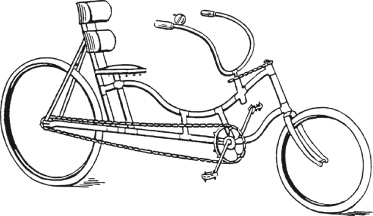
Figure 1.22
Brown’s 1900 recumbent bicycle. (From a sketch of the Sofa Bicycle in The Cyclist [UK], November 13, 1901, 785.)
Recumbents were then more successful in continental Europe. In 1921, after the First World War, the Austrian Zeppelin engineer (and later, car designer) Paul Jaray built recumbents in Stuttgart (Lessing 1998). The Swiss human-powered vehicle (HPV) club Future Bike has and occasionally uses its J-Rad (Future Bike 2018). It has swing-lever pedals with three leverages.
A racing recumbent called the Velocar (figure 1.23) was developed in France in 1931–1932 from four-wheeled pedaled vehicles of that name (Schmitz 1994). With a Velocar, a relatively unknown racing cyclist, Francis Faure, defeated the world champion, Henri Lemoine, in a 4 km pursuit race and broke track records that had been established on conventional machines (“The Loiterer” 1934).
At the time, a genuine orthodoxy pervaded the bicycle industry and the Union Cycliste Internationale (UCI), which controlled world bicycle racing. Instead of setting up a procedure and special category for machines such as the Velocar, the UCI, at the urging of the cycle trade, banned unconventional types of vehicles from organized competition, including recumbents like the Velocar. This decision denied novel ideas the opportunity of being tested and publicized through racing and thereby deterred experimentation and development.

Figure 1.23
Velocar. (From an advertisement of a licensor.)
Only with open-rule HPV competitions, which started in California in 1974 (and gave rise to the International Human Powered Vehicle Association and later other organizations) was the inventiveness of HPV designers again given an incentive in regard to recumbent design. With recumbent machines of a large variety of types now winning all classes of open races, the technological history of this type of vehicle, and of bicycles in general, is again being written. All recent single-person pedaled speed records for a streamlined bicycle (almost always a recumbent) over 200 m with a flying start have exceeded the motorway speed limits of most countries.
Although speed records continue to climb to levels never thought possible before, recumbents have never reached a significant market share in daily use, in spite of advantages they offer in safety and comfort. When given a chance to ride recumbent tricycles at shows, people line up and are excited, but they rarely buy them, for reasons of cost and space, compared to standard bicycles. Those with fairings, the velomobiles (see chapter 11), give excellent weather protection and are faster on the level, but slower steeply uphill, and their use is even more restricted than that of standard bicycles. Paradoxically, their large safety benefits, compared to standard bicycles, are not recognized, and they are instead compared to automobiles and regarded as extremely fragile.
Power-Assisted Bicycles
The first powered bicycle seems to have been Sylvester Roper’s steam bicycle of 1868, and in 1881 Gustave Trouvé demonstrated an electrified Starley Coventry Tricycle (and in the same year also a boat and an unmanned airship!). The 1932 Philips Simplex was probably the first commercially available electric bicycle (e-bicycle), although patents and prototypes go back to 1895 (see timelines in Ron 2013 and Henshaw and Peace 2010). Electric power-assist systems for bicycles appeared beginning in 1896, with Hosea Libbey’s Velocipedrome, detailed in Desmond 2019. However, until 1932, manufactured powered bicycles used gasoline engines. They were similar in character to the mopeds still manufactured today, which have pedals only for emergency uses (such as engine malfunction, depletion of gasoline, and exceptionally steep hills) and sometimes for starting the engine. (In addition, having pedals puts the vehicles into different legal categories in many countries.) Although they are technically human-powered hybrid vehicles, most mopeds were and are not designed for actual use of the pedals: they have short cranks, only one gear, and suboptimal seating positions, and the rolling resistance of the tires is not conductive to attractive pedaling. The going is hard without the engine, and with it, the gear ratio is inappropriate for pedal operation. Even the famous Velo Solex is of this type: the pedals are used only for starting and when engine torque is insufficient on steep hills.
Such moped bicycles are not the subject of this book and even less so those without pedals, which quickly evolved into motorcycles or motor scooters and got heavier and heavier. Ironically, today some electric motor scooters, in a quirky retro-evolution, are fitted with hardly usable pedals, to enable them to be licensed as bicycles in some countries.
There is one notable exception, however. Physician and HPV pioneer Allan Abbott (who probably carried out more projects in different HPV fields than anybody else) was concerned with the unhealthy lifestyles many people were leading, as at the time there were as many as 250,000 premature deaths per year in the United States due to insufficient exercise. Because many of these people spent a great deal of time driving motor vehicles and had no time or energy left to exercise, Abbott suggested that they exercise while driving, by means of pedals. His goal here was not primarily to improve the vehicles’ efficiency or reduce their environmental impact, and he therefore proposed fitting pedals even to powerful vehicles: gyms on wheels (see Abbott 1999). As a practical experiment in 1988 he fitted a bicycle with a small gasoline engine, but unlike in mopeds, in such a way that the engine would deliver power only when the rider pedaled: by connecting the engine’s throttle to a spring-loaded chain tensioner on the pedal drive. Only with enough tension on the chain would the engine rev up and deliver torque through a centrifugal clutch. Abbott quickly found out that his bike was fun to ride, more fun than the unpedaled mopeds with their inactive deadweight riders. Because the engine acted like a human-power amplifier, it rewarded the rider immediately with every turn of the pedal, especially when accelerating. With his flying hydrofoil colleague Alec Brooks (see chapter 10), Abbott later (1997) formed a company to market the first US “pedelec” e-bicycle (that is, a bicycle with an electric motor that runs only when the bicycle is pedaled), aptly named Charger.
The Coming of the Pedelecs
Other pioneers coinvented pedelecs around the same time. The first official mention of the principle involved in a pedal-driven e-bicycle is US Patent 3,884,317 to Augustus Kinzel in 1975, and US Patent 4,541,500 to Egon Gelhard in 1982 included a claim for the bicycle’s motor switching on above a road speed of 1 m/s. Yamaha invented its PAS Power Assist System in 1989, unveiled its first PAS bicycle in 1993, sold the first model (AX1, with a 235 W motor) in 1994, and had produced 200,000 PAS bicycles by mid-1997. PAS used torque and speed sensors to yield a true pedelec with a maximum power amplification of 200 percent (i.e., maximum 1:1 motor-to-human ratio, as required by Japanese regulations) up to 15 km/h and a gradual reduction to 0 percent at 24 km/h (see Cyclepress 1997).
PAS bicycles and similar pedelecs benefited from Japanese and European legislation designed to encourage them, up to a speed of 25 km/h. In Britain, this movement started in 1983 with the Electrically-Assisted Pedal Cycles Regulations, which allowed the free use of 200 W (250 W for tricycles) electric motors, provided they cut out at 15 mph (24 km/h) and the vehicles weighed less than 40 kg (60 kg for tricycles). In 2002 the European Union passed a similar directive with a cut-out of 25 km/h (15.6 mph), no weight restrictions, and a maximum power of 250 W, but with the difference that only pedelecs are allowed. The United States passed a rather different law in 2001 allowing 750 W motors and a top speed of 20 mph (32 km/h) for vehicles with functional pedals. In the same year Canada introduced regulations with the same speed restriction, but without the pedal requirement and with the motor power limited to 500 W. Both US states and Canadian provinces may impose additional legal requirements. Switzerland adopted the EU directive for a time but introduced its own speed category in 1992 (see the next section) and today has several categories differing from all others. Thus in each of these countries, e-bicycles evolved differently, even if today they are mostly similar, even when fitted out or programmed differently. By the time you read this, things will have changed again.
Velocity and the “Fast Class”
The first really good pedelec in the Western world (maybe even the absolutely first commercial pedelec) was the Velocity, developed by Michael Kutter of Switzerland, who devoted most of his life to the project. The first commercial version was sold in 1992 (the coauthor helped with the assembly and promotion of the first batch of 30 and still has his). The principle was so good that apart from component and name changes by licensees (to Dolphin [figure 1.24]; to Swizzbee, starting in 2004; and to iZip [Currie], starting in 2008), nothing needed to be changed. However, Kutter died at an early age in 2015 and with him his small company. Although no longer sold, in the opinion of the coauthor, Kutter’s invention remains the best type of pedelec, even if others have caught up considerably these twenty-five years later. It was probably the only mechanical series hybrid, and its functioning is explained in chapter 9.
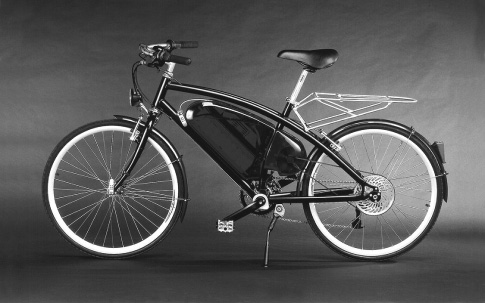
Figure 1.24
Velocity Dolphin assisted human-powered bicycle. (Courtesy of Michael Kutter.)
Kutter also “invented” something else of importance, however: the legal specification dubbed “Swiss fast class.” Previously specifications for e-bicycles in Switzerland (and many other countries) were not clear. Mopeds could have 50 mL two-stroke engines limited to 30 km/h, pedals had to be fitted but did not have to be used, and a license, insurance, and a heavy helmet were—and still are—all required. In 1992, Kutter convinced the Swiss authorities to adopt legislation conforming to the system his Velocity employed, which at the time meant a maximum nominal 250 W motor that could propel the bicycle no faster than 20 km/h on its own. Pedal speed could, however, be added—this being a true series hybrid—and as in a pure bicycle, the top speed was not limited by law, but only by the rider’s fitness. Because of increasing air resistance with an unfaired bicycle (no fairings being allowed here), it is not possible to go much faster than about 50 km/h for any useful amount of time even when helped by a nominal 250 W motor; indeed, the coauthor reached only 48 km/h with his Velocity in 200 m speed trials in 1999 at Interlaken Airport, even slightly downhill at −0.33 percent slope. Type approval is required (i.e., a certificate of conformity), as well as a moped license and insurance, and no tandems, tricycles, or (as noted) fairings are allowed in this vehicle category. No helmet was then required, and even with 250 W it was easy to overtake the much more powerful but 30 km/h–limited mopeds and with wind in one’s hair escape their poisons and noise!
The Velocity turned out to be the fastest of all vehicles for trips of average length and in average traffic conditions from A to B, won most e-bicycle races, and was later adopted by the Los Angeles bicycle police, who bought 100 iZip Expresses in 2012 (see Hicks 2012), in order to be faster than their “clients.” The nominal motor power had by then been increased to 750 W for the North American market; top speeds (of the police model) of about 40 mph (~64 km/h) were reported.
Why is this unique vehicle, best of all pedelecs, no longer made? (This had happened already before Kutter’s death.) It wasn’t only the high price or the unreliability of some parts (the coauthor broke the slightly overstressed rear axle twice), but even more so the catching up and overtaking of competing firms.
Flyer, BionX, and Others
In particular the Flyer brand was marketed heavily in the late 1990s and soon became a synonym for the e-bicycle in Switzerland. Several successive manufacturers produced a bewildering range of Flyers and soon cornered the senior-citizen market. Fleets of rental Flyers became available in tourist areas, complete with battery-exchange points, tour suggestions, and also organized trips. Most models had a rather aggressive initial acceleration (which pleased new customers). Today most e-bicycles generally have a good “feel” irrespective of the type of system used, but they haven’t achieved the Velocity Dolphin’s semiautomatic operation. The coauthor’s family Flyer has a 14-speed Rohloff hub gear and requires frequent gear changing on every trip. Even models using the NuVinci variable gear need constant attention (see chapter 9). We hope therefore for a revival of the Velocity system someday. (At the time of writing, the first true automatics are starting to appear, and the NuVinci also has an automatic mode.) For a long time, Flyer used the popular Panasonic crankshaft-integrated motor, and now it also uses similar ones from Bosch. These large firms supply many pedelec manufacturers.
Up to 2018, the Canadian firm BionX produced a very easy-to-install pedelec kit with a gearless hub motor complete with rear wheel. With this kit, any bike shop or small firm (including the coauthor’s neighbor, who is a farmer) could sell its own brand of pedelec. The first models of BionX’s pedelec kit were freely programmable (two dozen parameters!) even to higher-than-legal speeds. (Today they are tamper-proof “black boxes” that self-deactivate, for example, if an attempt is made to change battery cells.) Another farmer-founded bicycle firm (Stromer) produced souped-up BionX-type pedelecs for new Swiss fast-class regulations implemented in 2014, which—although speeds are now limited to 45 km/h in pedelec mode—have raised the permissible power to 1 kW (hardly used; even top models are usually under 500 W). Although these pedelecs use motor systems of international brands, their development has taken place mainly in Switzerland, as the legality of fast pedelecs in other countries remains patchy, from tolerated to forbidden.
These and similar firms, along with independent promoters of pedelecs, eventually boosted sales enormously mainly in Switzerland and somewhat in Germany, where in 1992 Hannes Neupert founded extraenergy.org, which assembled a large collection of available pedelecs, tested and displayed them all over Europe, and published data about them. In Great Britain, the Henshaw family, in A to B Magazine (atob.org.uk), tested and promoted e-bicycles on the British market (e.g., from Giant). In the United States Ed Benjamin surveyed and promoted e-bicycles at eCycle Electric (eCycleElectric.com) at least until 2014, estimating that sales had exceeded 170,000 per year. He had connections to China (as did Neupert) and found out that more than 200 million e-bicycles (in contrast to about 750,000 in Europe and the United States) had been produced there within a ten-year period! (These numbers probably include scooters and very low-performance bikes, however.)
China is now becoming an automobile country like the United States and many others, but in Switzerland fast pedelecs and slower e-bicycles (which unfortunately do not need to be pedelecs as in the European Union) have increased total bicycle usage, slowly leading to better supporting infrastructure. In traditional cycling countries that already have many cycle paths designed for low speeds, with many of them on sidewalks, fast pedelecs are less useful than they might otherwise be, as they can rarely be used at full speed. ExtraEnergy.org is therefore calling for North American–style speeds: a single free pedelec class limited to 32 km/h (20 mph) instead of the present 25 km/h (15.5 mph). The makers of assisted velomobiles and tandems, however, are calling for an assisted 45 km/h (28 mph) class instead of the present 25 km/h limit for these vehicles in Europe.
At the time of writing, e-bicycle usage is increasing rapidly in Switzerland, where e-bicycles accounted for one-third of all bicycle sales in 2018. Popular new types are e–mountain bikes and e–cargo bicycles and tricycles, in Switzerland and in other countries as well (see chapter 10).
References
Abbott, Allan V. 1999. “Health and the Reintegration of Physical Activity into Lifestyles in the New Millennium.” In Assisted Human Powered Vehicles (Proceedings of the 4th Velomobile Seminar, Aula Interlaken, Switzerland, August 18, 1999), ed. Andreas Fuchs and Theo Schmidt, 21–33. Liestal: Future Bike Switzerland. http://velomobileseminars.online.
Barrett, Roy. 1972. “Recumbent Cycles.” The Boneshaker (Southern Veteran-Cycle Club, UK), 227–243.
Baudry de Saunier, Louis. 1892. Le cyclisme théorique et pratique. Paris: Librairie Illustré.
Berto, Frank J. 1998. “Who Invented the Mountain Bike?” In Cycle History: Proceedings of the 8th International Cycle History Conference, Glasgow, Scotland, August 1997. San Francisco: Van der Plas.
Berto, Frank, Ron Shepherd, and Raymond Henry. 1999. The Dancing Chain. San Francisco: Van de Plas.
Clayton, Nick. 1997. “Who Invented the Penny-Farthing?” In Cycle History: Proceedings of the 7th International Cycle History Conference, Buffalo, NY, 1996. San Francisco: Van der Plas.
Clayton, Nick. 1998. Early Bicycles. Princes Risborough, UK: Shire.
Cyclepress. 1997. Japanese specifications statistics and information. Japanese, with English translation. Interpress, Tokyo.
Cycling. 1887. Badminton Library. London: Longman’s, Green.
Davies, Thomas Stephens. 1837. “On the Velocipede.” Address to the Royal Military College, Woolwich, UK. Reported, with notes by Hans-Erhard Lessing, in The Boneshaker, nos. 108 and 111 (1986).
Desmond, Kevin. 2019. Electric Motorcycles and Bicycles: A History Including Scooters, Tricycles, Segways and Monocycles. Jefferson, NC: McFarland.
Dodds, Alastair. 1992. “Kirkpatrick MacMillan—Inventor of the Bicycle: Fact or Fiction.” In Proceedings of the 3rd International Cycle History Conference. Saint Etienne, France: Ville de Saint Etienne.
Dodge, Pryor. 1996. The Bicycle. Paris: Flammarion. http://pryordodge.com/The_Bicycle_Book.html.
Dolnar, Hugh. 1902. “An American Stroke for Novelty.” Cyclist (London), January 8, 20.
Future Bike. 2018. “Das Sesselrad von Paul Jaray, Zeppelin-Konstrukteur und Erfinder der Stromlinienform für Autos.” http://futurebike.ch/page.asp?DH=2089&SE=jaray.
Gnudi, Martha Teach, trans., and Eugene S. Ferguson, annotator. 1987. The Various and Ingenious Mechanisms of Agostino Ramelli (1588). New York: Dover and Aldershot, UK: Scolar.
Hadland, Tony. 1987. The Sturmey-Archer Story. Self-published (UK).
Hadland, Tony, and Hans-Erhard Lessing. 2014. Bicycle Design. Cambridge, MA: MIT Press.
Henshaw, David, and Richard Peace. 2010. Electric Bicycles. Dorset, UK: Excellent Books. ExcellentBooks.Co.UK.
Hicks, Eric. 2012. “IZip Express Review.” Electric Bike, August 8. http://www.electricbike.com/izip-express/.
Katch, Frank L., William D. McArdle, and Victor L. Katch. 1997. “Edward Smith (1819–1874).” History Makers (website). http://www.sportsci.org/news/history/smith/smith.html.
Lessing, Hans-Erhard. 1991. “Around Michaux: Myths and Realities.” In Actes de la deuxième conference internationale sur l’histoire du cycle, St. Etienne, vol. 2. Ville de Saint-Etienne, France.
Lessing, Hans-Erhard. 1995. “Cycling or Roller Skating: The Resistible Rise of Personal Mobility.” In Cycle History: Proceedings of the 5th International Cycle History Conference. San Francisco: Van der Plas.
Lessing, Hans-Erhard. 1998. “The J Wheel—Streamline Pioneer Paul Jaray’s Recumbent.” In Cycle History: Proceedings of the 9th International Cycle History Conference, Ottawa, Canada, August 1998. San Francisco: Van der Plas.
Lessing, Hans-Erhard. 2017. Veteran-Cycle Club Cycling History, no. 8.
“Loiterer, The.” 1934. In “Velocar versus Normal,” Cycling, March 2, 202.
McGurn, Jim. 1999. On Your Bicycle: The Illustrated Story of Cycling. York, UK: Open Road.
Mirror, The (newspaper). 1822. “The Tread-Mill at Brixton.” November 2.
Oddy, Nicholas. 1990. “Kirkpatrick MacMillan, the Inventor of the Pedal Cycle, or the Invention of Cycle History.” In Proceedings of the 1st International Cycle History Conference, Glasgow. Cheltenham, UK: Quorum.
Oke, Olufolajimi, Kavi Bhalla, David C. Love, and Sauleh Siddiqui. 2015. “Tracking Global Bicycle Ownership Patterns.” Journal of Transport and Health 2, no. 4: 490–501.
Pinkerton, John. 1983. At Your Service: A Look at Carrier Cycles. Birmingham, UK: Pinkerton.
Pinkerton, John, and Derek Roberts. 1998. A History of Rover Cycles. Birmingham, UK: Pinkerton.
Ritchie, Andrew. 1975. King of the Road: An Illustrated History of Cycling. Berkeley, CA: Ten Speed.
Roberts, Derek. 1991. Cycling History—Myths and Queries. Birmingham, UK: Pinkerton.
Ron/Spinningmagnets. 2013. “Electric Bike History, Patents from the 1800’s [to 1995].” Electric Bike, November 9. https://www.electricbike.com/e-bike-patents-from-the-1800s/.
Schmitz, Arnfried. 1994. “Why Your Bicycle Hasn’t Changed for 106 Years.” Human Power 13, no. 3 (1994): 4–9; originally published in Cycling Science (June 1990). http://www.ihpva.org/HParchive/PDF/46-v13n3-1998.pdf.
Sharp, Archibald. 1896. Bicycles and Tricycles. London: Longmans, Green. Reprint, Cambridge, MA: MIT Press, 1977.
Street, Roger. 1998. The Pedestrian Hobby-Horse at the Dawn of Cycling. Christchurch, UK: Artesius.
von Salvisberg, Paul. 1897. Der Radfahrsport in Bild und Wort. Munich. Reprint, Hildesheim, Germany: Olms, 1980.
Vaver, Anthony. 2013. “Prisons and Punishments: The Failure of the Treadmill in America.” Last modified February 27, 2013. Early American Crime (website). http://www.earlyamericancrime.com/prisons-and-punishments/failure-of-the-treadmill.
Walton, Geri. 2015. “The Treadmill for Punishment.” Geri Walton (website). http://www.geriwalton.com/the-treadmill-for-punishmen/.
Wilson, David Gordon. 1977. “Human Muscle Power in History.” In Pedal Power, ed. James C. McCullagh. Emmaus, PA: Rodale.